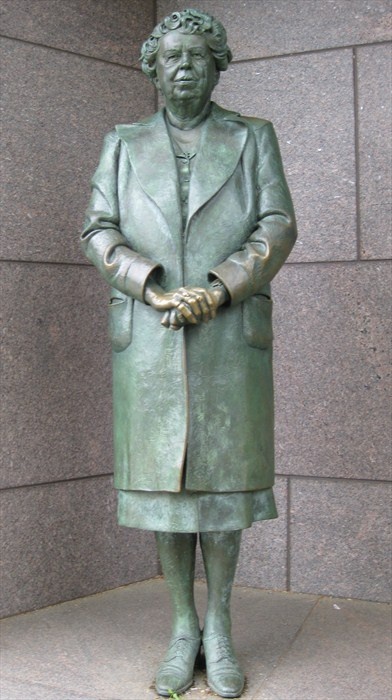 |
| Eleanor Roosevelt |
Anna Eleanor Roosevelt was the wife of Franklin D. Roosevelt and first lady of the United States from 1933 until 1945, becoming a United Nations diplomat and a major political figure in her own right.
She was born on October 11, 1884, in New York, the daughter of Elliott and Anna Hall Roosevelt and niece of Theodore Roosevelt, who became the 26th president of the United States. Both her parents died when she was young—her mother when she was eight and her father when she was nine, and as a result she was raised by relatives, rapidly becoming Theodore Roosevelt's favorite niece. It was the childhood of a wealthy girl, and she quickly developed a social conscience and keenness to help with charitable works.
She was educated at Allenswood, near London, England, and later described the three years she spent there as the happiest in her life. In 1902 she returned to New York, and three years later, on March 17, 1905, she married a distant cousin, Franklin Delano Roosevelt.
  |
They were to have six children: Anna Eleanor, born in 1906; James, born in 1907; Franklin Delano, Jr., born in 1909 (died aged seven and a half months); Elliot, born in 1910; Franklin Delano, Jr., born in 1914; and John Aspinwall
Even before her marriage, Eleanor Roosevelt had been active in charity and volunteer work, and she adapted easily to the task of accompanying her husband as he entered politics. The family moved to Albany after Franklin won a seat in the New York senate in 1911, and two years later they moved to Washington, D.C., when he was appointed assistant secretary of the navy. During World War I, Eleanor worked in a Red Cross
A particularly traumatic time came about in 1918 when Eleanor discovered that her husband was having an affair with her social secretary, Lucy Mercer
In 1921 Franklin Roosevelt was struck with poliomyelitis
When Franklin was elected governor of New York in 1929, Eleanor remained an adept political hostess but also continued to run a Manhattan girls' school, Todhunter, which she and two friends had recently bought. Eleanor taught at the school and enjoyed her independence from political life.
When Franklin Roosevelt was elected president, Eleanor became a leading advocate for liberal causes, especially women's rights and equal rights for African Americans. She held a regular White House press conference restricted to women journalists.
This ensured that many major newspapers had to hire women correspondents, if only, some would later admit, to get the news from her. With Franklin crippled, Eleanor toured the United States many times in his absence and was able to tell him about the success or otherwise of social programs.
 |
| Roosevelt speaking at the United Nations in July 1947 |
Eleanor Roosevelt's championing of the rights of African Americans quickly became famous throughout the United States and overseas. In 1939 the Daughters of the American Revolution refused to allow Marian Anderson
In 1945 Franklin Roosevelt died, and his successor, Harry S. Truman, who called Eleanor the "First Lady of the World," appointed her to be a delegate to the United Nations, where she was chair of the Commission on Human Rights from 1946 until 1952, playing a major role in the drafting and then the adopting of the Universal Declaration of Human Rights in 1948.
She was appointed in 1961 by President John F. Kennedy to chair the Commission on the Status of Women, and she came to support the Equal Rights Amendment. From 1945 Eleanor Roosevelt traveled around the world many times, unveiling a statue of Franklin Roosevelt at Grosvenor Square, London, in April 1948 and going to Yugoslavia and the Soviet Union, as well as most Western countries.
 |
| Statue of Eleanor Roosevelt - Washington, DC. |
Eleanor Roosevelt died on November 7, 1962, from tuberculosis, and was buried at Hyde Park, New York, where her husband had been buried 17 years earlier.